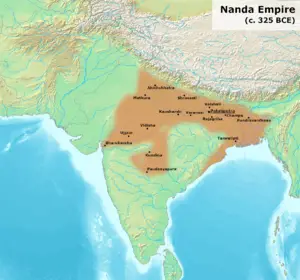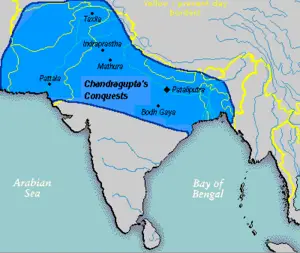How Did the Mauryan Dynasty Come to Power
The Mauryan Dynasty (321-185) was the first major empire to unite most of India under a single ruler. Before the Mauryan kings came to power, the subcontinent was a collection of small kingdoms and clan based states that viewed each other as more different than alike and who were often at war. The Mauryan Dynasty is best known for the third king of the line, Ashoka, due to his promotion of Buddhism and the many rock and pillar edicts he had installed throughout the kingdom, but the dynasty’s first king, Chandragupta and his successor Bindusara established the system that allowed the kingdom to flourish.
The early Mauryan kings were able to be successful because they pursued a three pillared government policy that was ambitious, far-reaching, and well-planned. Chandragupta initiated his dynasty’s assent into power by challenging the Nanda Dynasty, which ruled northern India. After defeating the Nanda Dynasty, Chandragupta then filled the power vacuum in northwest India that was left by Alexander the Great after his ill-fated invasion. Finally, and perhaps most importantly, the early Mauryan kings installed a strong central government that was not afraid to ruthlessly suppress dissent if need be.
India before the Mauryan Dynasty
The history of pre-modern India is divided into several major periods, with several more sub-periods. The period in Indian history from about 1,500 to 600 BC is known as the Vedic Period. This period was marked by a primarily rural society that was ruled by an ethnic Aryan warrior aristocracy, although the Dravidians in the south remained relatively free of direct Aryan control. After 600 BC, though, urban based kingdoms began developing throughout India, especially in the eastern and middle regions. [1]
The region of Madhyadesha (middle India), which is more specifically located in the northeastern Ganges River basin, became the site of one of the most powerful early states – Magadha. The cities of Rajagriha and Pataliputra were the capitals of this post-Vedic state, which came to be ruled by a succession of powerful dynasties. [2] The first post-Vedic Magadha dynasty was the Haryanka, which was followed by the Shushunaga. The Nanda Dynasty was in power during the time of Alexander’s invasion and although they did not control the Indus Valley, the Nandas certainly had a fair amount of influence in the region. [3]
Alexander the Great’s invasion of India essentially hastened the process of state formation that was already taking place in the subcontinent. The Macedonian-Greek army first encountered the Assakenois people near what is today the border between Kashmir and Pakistan before moving on to confront bigger foes. Ambhi the ruler of Taxil, decided that discretion was the better part of valor and collaborated with Alexander, while a king named Porus, who controlled territory between the Heleum and Chenab rivers, decided to resist Alexander. [4] After intense fighting where the Greeks were introduced to elephant warfare, Alexander finally subdued Porus, although he allowed him to keep his title and rule in return for fealty. Alexander wished to continue east, past the Ganges River, but his men threatened mutiny so the expedition was cancelled and most of the army returned to Babylon. [5]
Although Porus nominally remained in power, his army and position vis à vis the other Indian states was severely weakened. Less than five years after Alexander left India in defeat, a conqueror from the east entered the Indus Valley.
Chandragupta’s Rise to Power
Although Chandragupta is well-known as the founder of the Mauryan Dynasty and the promoter of many of its successful policies, there is a dearth of primary source material about the ruler. Later Buddhist sources state that he was from the kshatriya or warrior caste, while Brahman sources depict him as being from the lowly shudra caste. [6]
The seeming contradictions in the sources may be related to religious considerations more than anything. Chandragupta became a pious Jain late in his life and his grandson, Ashoka converted to and promoted Buddhism. The general confusion surrounding the lack of coherency and chronology of texts relating to Chandragupta’s lives was alleviated to some degree when British scholar William Jones definitively connected the Indian king to the mysterious “Sandrocuttus” mentioned by classical historians. [7] Once historians knew that Chandragupta was Sandrocottus, combined with advances in archaeology and Sanskrit philology, modern scholars could better reconstruct his early life and the formation of the Mauryan Dynasty.
Chandragupta began his rule in 321 BC after conquering the Nanda Empire in a very deliberate manner, working from the edges inward, take the Indus Valley in the northwest after Alexander the Great and his army left. [8] After subjugating northwest India, Chandragupta was left in control over all northern India, which consisted of the politically and culturally important, and fertile, Indus and Ganges valleys.
Chandragupta in Power
Once Chandragupta attained power and extended his empire’s borders to include most of India, he also faced the tough task of building a strong state internally. The Mauryan Dynasty and Chandragupta’s name never would have been known to later generations if it were not for the ruler’s efforts of domestic reform. Although Chandragupta was a Jain later in his life and abstained from all violence, he was not afraid to use violence, or the threat of it early in his rule. Chandragupta initiated harsh penal codes for lawbreakers and called on his chief minister, Kautalya, to compose a treatise of proper government.
The text that Kautalya gave to Chandragupta, known as the Arthashastra, advocated the formation of a corrupt free state that was administered by a well-organized and efficient bureaucracy. The government itself was highly centralized and could be quite brutal towards recalcitrant princes, taxpayers, and other assorted rebels. [9]
Perhaps one of the most important steps Chandragupta and his son and successor, Bindusara (reigned c. 297-273 BC) took was to open trade and diplomatic relations with the Greek/Hellenistic Seleucid Empire. Although Seleucus I (ruled 305-281 BC) had nominal control over at least part of the Indus Valley following Alexander’s invasion, he agreed to give up the territory in return for some elephants and an alliance. The first BC Greek geographer, Strabo, wrote:
“The Indus lies, latitudinally, alongside all these places; and of these places, in part, some that lie along the Indus are held by Indians, although they formerly belonged to the Persians. Alexander took these away from the Arians and established settlements of his own, but Seleucus Nicator gave them to Sandrocottus, upon terms of intermarriage and of receiving in exchange five hundred elephants.” [10]
According to the second century Greek historian, Polybius, the alliance that was made between Chandragupta and Seleucus I was renewed by Antiochus I (reigned 281-261 BC), Seleucus I’s successor, and an Indian king named “Sophagasenus.” Sophagasenus has not yet been identified, although Antiochus I’s rule coincided with Bindusara’s rule in India, so it is likely he was the mysterious king, or possibly Sophagesnus could have been a local prince.
“Antiochus took his departure, serving out generous rations of corn to his troops and adding to his own the elephants belonging to Euthydemus. Crossing the Caucasus he descended into India and renewed his alliance with Sophagasenus the Indian king. Here he procured more elephants, so that his total force of them amounted now to a hundred and fifty, and after a further distribution of corn to his troops, set out himself with his army, leaving Androsthenes of Cyzicus to collect the treasure which the king had agreed to pay.” [11]
But the early Mauryan kings were foresighted enough to know that the Seleucids were not the only Greek power at the time. According to Strabo, the Ptolemies of Egypt, who were also contemporary with the Mauryan Dynasty, engaged in long-distance trade with India.
“At any rate, when Gallus was prefect of Egypt, I accompanied him and ascended the Nile as far as Syene and the frontiers of Ethiopia, and I learned that as many as one hundred and twenty vessels were sailing from Myos Hormos to India, whereas formerly, under the Ptolemies, only a very few ventured to undertake the voyage and to carry on traffic in Indian merchandise.” [12]
Conclusion
The Mauryan Dynasty is often viewed as a golden age in Indian history and a bridge between the historically hazy Vedic Period and later medieval India. Chandragupta and Bindusara were able to build their dynasty into a great empire through some politically astute policies and a little luck. As he defeated the Nanda Dynasty, Chandragupta filled the void left by Alexander and Macedonians in the Indus Valley of northwest India. After establishing his dynasty as a true empire that ruled over most of India, Chandragupta and then Bindusara created a strong central government and made alliances with the Hellenistic kingdoms to the west, which all helped to stabilize the Mauryan state.
References
- Jump up ↑ Avaru, Burjor. India: The Ancient Past: A History of the Indian Sub-continent from c. 7000 BC to AD 1200. (London: Routledge, 2007), pgs. 86-87
- Jump up ↑ Scialpi, Fabio. “The Ethics of Aśoka and the Religious Inspiration of the Achaemenids.” East and West 34 (1984) pgs. 300-2
- Jump up ↑ Avari, pgs. 90-91
- Jump up ↑ Avari, p. 92
- Jump up ↑ Plutarch. The Age of Alexander: Ten Greek Lives by Plutarch. Translated by Ian Scott Kilvert and Timothy E. Duff. (London: Penguin Books, 2012), Alexander, LXII
- Jump up ↑ Thapar, Romila. Early India: From the Origins to AD 1300. (Los Angeles: University of California Press, 2002), pgs. 175-6
- Jump up ↑ Avari, p. 106
- Jump up ↑ Thapar, p. 176
- Jump up ↑ Avari, pgs. 107-8
- Jump up ↑ Strabo. Geography. Translated by Horace Leonard Jones. (Cambridge, Massachusetts: Harvard University Press, 2001), XV, 2, 9
- Jump up ↑ Polybius. The Histories. Translated by W. R. Paton. (Cambridge, Massachusetts: Harvard University Press, 1960), XI, 39, 10-13
- Jump up ↑ Strabo, II, 12


